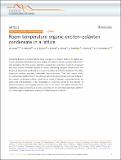Files in this item
Room temperature organic exciton-polariton condensate in a lattice
Item metadata
| dc.contributor.author | Dusel, M. | |
| dc.contributor.author | Betzold, S. | |
| dc.contributor.author | Egorov, O. A. | |
| dc.contributor.author | Klembt, S. | |
| dc.contributor.author | Ohmer, J. | |
| dc.contributor.author | Fischer, U. | |
| dc.contributor.author | Höfling, Sven | |
| dc.contributor.author | Schneider, C. | |
| dc.date.accessioned | 2020-06-30T12:30:01Z | |
| dc.date.available | 2020-06-30T12:30:01Z | |
| dc.date.issued | 2020-06-08 | |
| dc.identifier | 267941050 | |
| dc.identifier | 7e7c285d-fe84-4c2d-8cd3-27b99460adf3 | |
| dc.identifier | 000541702400002 | |
| dc.identifier | 85086038155 | |
| dc.identifier.citation | Dusel , M , Betzold , S , Egorov , O A , Klembt , S , Ohmer , J , Fischer , U , Höfling , S & Schneider , C 2020 , ' Room temperature organic exciton-polariton condensate in a lattice ' , Nature Communications , vol. 11 , 2863 . https://doi.org/10.1038/s41467-020-16656-0 | en |
| dc.identifier.issn | 2041-1723 | |
| dc.identifier.uri | https://hdl.handle.net/10023/20178 | |
| dc.description | Funding: The Würzburg group acknowledges financial support from the state of Bavaria. We also thank the Würzburg–Dresden Cluster of Excellence ct.qmat for financial support. | en |
| dc.description.abstract | Interacting Bosons in artificial lattices have emerged as a modern platform to explore collective manybody phenomena and exotic phases of matter as well as to enable advanced on-chip simulators. On chip, exciton–polaritons emerged as a promising system to implement and study bosonic non-linear systems in lattices, demanding cryogenic temperatures. We discuss an experiment conducted on a polaritonic lattice at ambient conditions: We utilize fluorescent proteins providing ultra-stable Frenkel excitons. Their soft nature allows for mechanically shaping them in the photonic lattice. We demonstrate controlled loading of the coherent condensate in distinct orbital lattice modes of different symmetries. Finally, we explore the self-localization of the condensate in a gap-state, driven by the interplay of effective interaction and negative effective mass in our lattice. We believe that this work establishes organic polaritons as a serious contender to the well-established GaAs platform for a wide range of applications relying on coherent Bosons in lattices. | |
| dc.format.extent | 7 | |
| dc.format.extent | 1182546 | |
| dc.language.iso | eng | |
| dc.relation.ispartof | Nature Communications | en |
| dc.subject | QC Physics | en |
| dc.subject | TK Electrical engineering. Electronics Nuclear engineering | en |
| dc.subject | NDAS | en |
| dc.subject.lcc | QC | en |
| dc.subject.lcc | TK | en |
| dc.title | Room temperature organic exciton-polariton condensate in a lattice | en |
| dc.type | Journal article | en |
| dc.contributor.institution | University of St Andrews. Condensed Matter Physics | en |
| dc.contributor.institution | University of St Andrews. School of Physics and Astronomy | en |
| dc.identifier.doi | https://doi.org/10.1038/s41467-020-16656-0 | |
| dc.description.status | Peer reviewed | en |
This item appears in the following Collection(s)
Items in the St Andrews Research Repository are protected by copyright, with all rights reserved, unless otherwise indicated.

